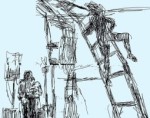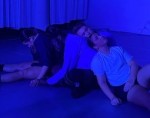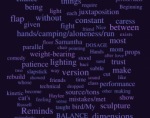
Mother to Son, Son to Mother - Megan Bridge and Tristan Price Celebrate Whistler and Bach
by Rhonda Moore
For the first time in 142 years, James Abbott McNeill Whistler’s iconic portrayal, Arrangement in Grey and Black: Portrait of the Artist’s Mother, is on view in Philadelphia through October 29. The Philadelphia Museum of Art’s exhibition The Artist’s Mother: Whistler and Philadelphia brings Whistler’s portrait into dialogue with works by artists associated with the city—Cecilia Beaux, Henry Ossawa Tanner, John Sloan, Dox Thrash, Alice Neel, and Sidney Goodman—and their relationship with their mothers through their practices.
The Whistler exhibit at the PMA proves a perfect niche for introducing a live, interdisciplinary performance into the conversation. Celebrated Philadelphia-based improvisational movement artist Megan Bridge* and son, prodigious cellist Tristan Price, were invited to present their in-the-moment sonic and embodied response to the exhibit’s driving theme of the mother-son relationship.
The suggestion of the Bach Cello Suites as subject material for this mother/son collaboration is attributed to Bridge’s partner Peter Price, himself a composer, electronic musician, and digital artist. Bridge is an able improvisational mover, and the suites offer a fertile landscape for exploration as the musical score contains little to no suggestions of any kind regarding tempo, phrasing, mood, or intention. While open debate continues around why the Cello Suites lack this information (even the transcribed score of Bach’s second wife Anna Magdalena is paltry in regard), the omission creates the de facto obligation of any individual performer to wrestle with and settle upon artistic choices, each one of potentially monumental impact on the final interpretation.
The result is a marvelous connubiality of the keenest sort, buoyed by the undeniable artistic excellence of the piper and the jester. It actually seems like Tristan Price is “wooing” the woman before him—his mother—to move. In response, she is at the beck and call of whatever his instrument pronounces. Situated in the large space at the base of the Great Stair Hall, Price sits in the upstage left corner and begins the Prelude. Bridge stands close by, listening and looking, gently absorbing the sound. The music is familiar; yes, it’s the Prelude to the G major Cello Suite.
The regal repeating arpeggios of the opening suggest the idea of a question or curiosity about something that lies ahead. Price’s opening notes, luscious in their sound, intimate a great sensitivity and understanding of interpretation and involvement well beyond his adolescent years. Bridge’s physical responses are clearly sparked by what she hears. The dancing begins with subtle, articular impulses; everything is understated, a sort of tickling. Bridge’s movements are small: quivering fingers take in the notes, then the sound seems to gently run through the spine. The rib cage is smoothly aroused, and the shoulders respond with implied waves. Facial features awaken, and the gaze, a particular and almost trademarked nuance of Bridge’s dance works, is ever-present. Bridge makes intentional choices about the depth of looking; it’s inward and personal, like dancing as if no one is looking, or measuredly including anyone within her immediate range of vision, and then a full widening to include the vastness of the space.
The six movements in Bach’s suite encompass a journey through alternating states of presentation and grandness, questioning and positing, introspection and travail, daredevil antics and impish playfulness. The Bridge and Price collaboration presents two nimble performers who possess a deliciously nuanced sense of timing. There’s an almost reverential acknowledgement of the sustained tones during the legato sections of the suite, and an intentional underlining of the percussive quality of livelier sections, like the Courante. Where the sound stretches, Bridge indulges us with long, luscious and invitational arm extensions. During the pensive Sarabande, she initially responds by laying on the floor in splayed supine form, stilling her breath, and listening, always. She begins a slow rise, allowing the body weight to sequentially gather itself to standing.
I’ve taken the liberty of coining the Gigue, the final movement in the suite, as the neo-classical expression of a rock star sendoff. The tension and mounting energy created by the music’s intermingling contrapuntal rhythms and melodies transformed the final moments of this mother and son duo into a wildly mad, yet ever-elegant visual and sonorial chase. The music and the movement entertain one another in “no holds barred” tactics: Price’s graceful notes connect with his mother’s quirkily sophisticated physical embellishments. Bridge’s head toss, shoulder shrug, implied fall and quick, airborne spin sublimely celebrate the musical textures suggested by Bach’s notes, brought into this particular time and space with the mindfulness of Tristan Price.
In conversation with mother and son during a final rehearsal just days before the show, I inquired about their greatest discovery during this first collaboration. I’ve paraphrased their replies in two words—Price: “being heard,” and Bridge: “learning trust.” Their responses certainly underscore the communicative and transformative power of music and dance. The exchange being one between mother and son makes these revelations all the more meaningful, ripe with the promise of further music-and-movement-provoking conversations down the road.
*Megan Bridge is a writer and the former Director of thINKingDANCE.
The Bach Cello Suites Project Performance, Megan Bridge and Tristan Price, Philadelphia Museum of Art, July 29. In collaboration with The Artist’s Mother: Whistler and Philadelphia, June 10 – Oct. 29
By Rhonda Moore
August 6, 2023










